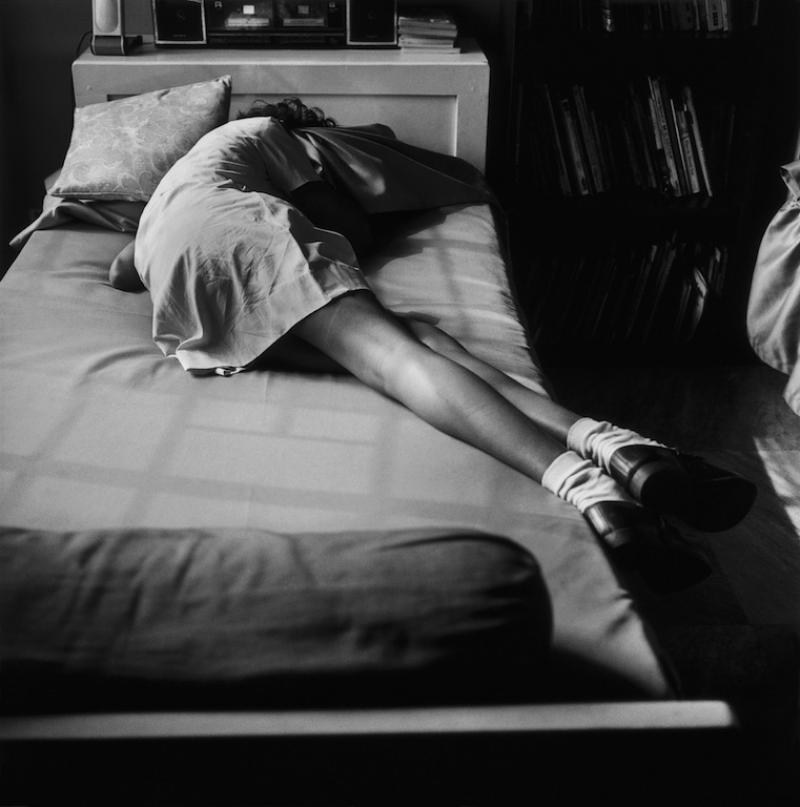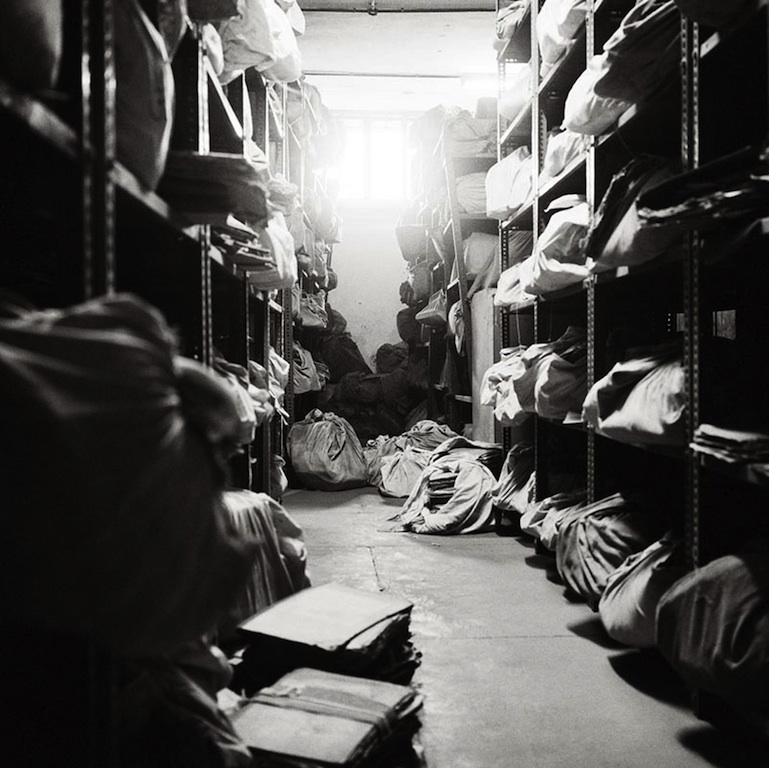Dayanita Singh: Go Away Closer, Hayward Gallery | reviews, news & interviews
Dayanita Singh: Go Away Closer, Hayward Gallery
Dayanita Singh: Go Away Closer, Hayward Gallery
A brilliant photographer who wants to be seen as a poet

In the 25 years she has spent taking photographs, Dayanita Singh has accumulated a huge body of evocative and memorable images. For instance, there’s the girl lying face down on a bed (main picture), dressed in what looks like her school uniform. She lies awkwardly, her legs stretched diagonally across to the edge of the mattress, presumably so that her shoes won’t dirty the sheets. Why didn’t she take her shoes off?
 Propped up on one arm on a bedspread decorated with leaping fish, in Zeiss Ikon (1996) (pictured right) a beautiful young woman gazes thoughtfully to camera. She would probably get up if it weren’t for the restraining arms clasped round her waist by the man beside her. Is he her husband, and does she feel trapped or comforted by his proprietorial embrace? Such questions are unanswerable, of course; that is the beauty of still images. By provoking reverie about the circumstances surrounding the picture, they invite you to weave stories around the people and things portrayed. You are free to scan the pictures searching for clues, while luxuriating in the knowledge that the moment has been fixed; your intrusive gaze has no consequences.
Propped up on one arm on a bedspread decorated with leaping fish, in Zeiss Ikon (1996) (pictured right) a beautiful young woman gazes thoughtfully to camera. She would probably get up if it weren’t for the restraining arms clasped round her waist by the man beside her. Is he her husband, and does she feel trapped or comforted by his proprietorial embrace? Such questions are unanswerable, of course; that is the beauty of still images. By provoking reverie about the circumstances surrounding the picture, they invite you to weave stories around the people and things portrayed. You are free to scan the pictures searching for clues, while luxuriating in the knowledge that the moment has been fixed; your intrusive gaze has no consequences.
Brought up in a household full of unspoken rivalries and tensions, I spent my childhood carefully watching, and analysing people’s body language in an attempt to interpret what was going on beneath the surface restraint; so series such as Privacy, which consists of photographs of well-heeled families from the milieu in which Singh grew up in New Delhi, are meat and drink to me. Clustered around an armchair, a man and two women form a tight triangle of affection overlooked by the portrait of a woman on a nearby chest of drawers. Is this amicable trio a daughter and her parents? And can their relationship really be as benign as the picture implies?
 There are other ways of looking at these subtly complex family portraits, though. Instead of scrutinising each shot, you might prefer to compare and contrast. You may notice the reflections in the many shiny floors or, comparing the furniture in one comfortable home with another, you might wonder at the spareness of some rooms and the clutter of others.
There are other ways of looking at these subtly complex family portraits, though. Instead of scrutinising each shot, you might prefer to compare and contrast. You may notice the reflections in the many shiny floors or, comparing the furniture in one comfortable home with another, you might wonder at the spareness of some rooms and the clutter of others.
This is the approach preferred by Singh. Tired of being perceived merely as a photographer, she now spends most of her time selecting and presenting her pictures in groups and clusters. She likens the process to writing, each image being treated like a word which she adds to others to form sentences. “Photography is not enough for me,” she says. “It is just my language. Unless I can make poetry out of it, or a novel, what good is all my vocabulary?”
It first began with Sent a Letter (Steidl, 2008); concertinas of postcard-sized photographs are enclosed in hand-made boxes labelled with the ditty “Sent a letter to my friend/ On the way he dropped it/ Someone came and picked it up and put it in his pocket”. Each box forms the diary of a journey embarked on with the person the set is addressed to and, as they unfold, the images form a personal travelogue that has its own pace and rhythm.
 Singh is obsessed with museums and archives. Among her most memorable photographs are shots of musty rooms (pictured above left) piled high with personal files and bundles of mouldering documents – testaments to India’s notoriously complex bureaucratic system. After Sent a Letter she made numerous books including Privacy (Steidl, 2004), but they could not satisfy her desire to create her own archive in which her photographs could be presented as an installation.
Singh is obsessed with museums and archives. Among her most memorable photographs are shots of musty rooms (pictured above left) piled high with personal files and bundles of mouldering documents – testaments to India’s notoriously complex bureaucratic system. After Sent a Letter she made numerous books including Privacy (Steidl, 2004), but they could not satisfy her desire to create her own archive in which her photographs could be presented as an installation.
Dominating her Hayward show are seven Museums (pictured below with the artist), library style structures made from oiled teak in which photographs are presented according to themes such as Furniture, Chance, Machines and Embraces. Since each framed print is identical in size and format, one is encouraged to view each picture as a part of an inventory of things encountered and recorded rather than an element in its own right. The net effect is to direct attention away from the evanescent magic of the images themselves towards the mind which is ordering them – to think about the photographer, rather than the poetic moments she has captured.
 Housed in the Museum of Chance, for instance, is a photograph of muslin curtains (pictured above right) drifting in the breeze wafting through an open window. Seen alone, the image evokes blissful moments of silence and rest, but incarcerated in her installation it becomes an ingredient in a visual essay on happenstance. Instead of inviting her audience to dream, she offers us her own thoughts and interpretations. While I can understand why Singh would want to control the selection and presentation of her work and use her image bank as a bountiful resource, as a viewer I can’t help feeling a terrible sense of loss.
Housed in the Museum of Chance, for instance, is a photograph of muslin curtains (pictured above right) drifting in the breeze wafting through an open window. Seen alone, the image evokes blissful moments of silence and rest, but incarcerated in her installation it becomes an ingredient in a visual essay on happenstance. Instead of inviting her audience to dream, she offers us her own thoughts and interpretations. While I can understand why Singh would want to control the selection and presentation of her work and use her image bank as a bountiful resource, as a viewer I can’t help feeling a terrible sense of loss.
- Dayanita Singh: Go Away Closer at the Hayward Gallery until 15 December
Explore topics
Share this article
more Visual arts
 Fantastic Machine review - photography's story from one camera to 45 billion
Love it or hate it, the photographic image has ensnared us all
Fantastic Machine review - photography's story from one camera to 45 billion
Love it or hate it, the photographic image has ensnared us all
 Yinka Shonibare: Suspended States, Serpentine Gallery review - pure delight
Weighty subject matter treated with the lightest of touch
Yinka Shonibare: Suspended States, Serpentine Gallery review - pure delight
Weighty subject matter treated with the lightest of touch
 Jane Harris: Ellipse, Frac Nouvelle-Aquitaine MÉCA, Bordeaux review - ovals to the fore
Persistence and conviction in the works of the late English painter
Jane Harris: Ellipse, Frac Nouvelle-Aquitaine MÉCA, Bordeaux review - ovals to the fore
Persistence and conviction in the works of the late English painter
 Sargent and Fashion, Tate Britain review - portraiture as a performance
London’s elite posing dressed up to the nines
Sargent and Fashion, Tate Britain review - portraiture as a performance
London’s elite posing dressed up to the nines
 Zineb Sedira: Dreams Have No Titles, Whitechapel Gallery review - a disorientating mix of fact and fiction
An exhibition that begs the question 'What and where is home?'
Zineb Sedira: Dreams Have No Titles, Whitechapel Gallery review - a disorientating mix of fact and fiction
An exhibition that begs the question 'What and where is home?'
 Yoko Ono: Music of the Mind, Tate Modern review - a fitting celebration of the early years
Acknowledgement as a major avant garde artist comes at 90
Yoko Ono: Music of the Mind, Tate Modern review - a fitting celebration of the early years
Acknowledgement as a major avant garde artist comes at 90
 Unravel: The Power and Politics of Textiles in Art, Barbican review - the fabric of dissent
An ambitious exploration of a neglected medium
Unravel: The Power and Politics of Textiles in Art, Barbican review - the fabric of dissent
An ambitious exploration of a neglected medium
 When Forms Come Alive, Hayward Gallery review - how to reduce good art to family fun
Seriously good sculptures presented as little more than playthings or jokes
When Forms Come Alive, Hayward Gallery review - how to reduce good art to family fun
Seriously good sculptures presented as little more than playthings or jokes
 Entangled Pasts 1768-now, Royal Academy review - an institution exploring its racist past
After a long, slow journey from invisibility to agency, black people finally get a look in
Entangled Pasts 1768-now, Royal Academy review - an institution exploring its racist past
After a long, slow journey from invisibility to agency, black people finally get a look in
 Barbara Kruger, Serpentine Gallery review - clever, funny and chilling installations
Exploring the lies, deceptions and hyperbole used to cajole, bully and manipulate us
Barbara Kruger, Serpentine Gallery review - clever, funny and chilling installations
Exploring the lies, deceptions and hyperbole used to cajole, bully and manipulate us
 Richard Dorment: Warhol After Warhol review - beyond criticism
A venerable art critic reflects on the darkest hearts of our aesthetic market
Richard Dorment: Warhol After Warhol review - beyond criticism
A venerable art critic reflects on the darkest hearts of our aesthetic market
 Dineo Seshee Raisibe Bopape: (ka) pheko ye / the dream to come, Kiasma, Helsinki review - psychic archaeology
The South African artist evokes the Finnish landscape in a multisensory installation
Dineo Seshee Raisibe Bopape: (ka) pheko ye / the dream to come, Kiasma, Helsinki review - psychic archaeology
The South African artist evokes the Finnish landscape in a multisensory installation

Add comment